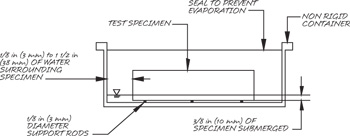ASTM C 1262
Standard Test Method for Evaluating the Freeze-Thaw Durability of Manufactured Concrete Masonry Units and Related Concrete Units
Section 5
The following summarizes the contents of ASTM C 1262 and key components of the test methods used to determine relative freeze thaw durability. This does not provide a comparison to field performance but a systematic approach to testing. A copy of the full standard is available upon request. This summary attempts to provide the information which is most commonly used, but Allan Block does not claim that all information contained in the standard is represented.
1. Scope
1.1 This test method covers the resistance to freezing and thawing of dry-cast segmental retaining wall (SRW) units (see Specification C1372) and related concrete units. Units are tested in a test solution that is either water or 3 % saline solution depending on the intended use of the units in actual service.
Note 1: Related concrete units include units such as hollow and solid concrete masonry units, concrete brick, and concrete roof pavers.
4. Significance and Use
4.1 The procedure described in this test method is intended to determine the effects of freezing and thawing on SRW and related units in the presence of water or saline solution.
4.2 The procedure is not intended to provide a quantitative measure to determine an expected length of service for a specific type of concrete unit.
6. Sampling and Preparation of Test Methods
6.1 Selection ofTest Units — Select five whole SRW units representative of the lot from which they are selected.The units shall be free from visible cracks or structural defects.
6.2 Number of Specimens — Test specimens shall consist of solid coupons saw-cut from full sized units. Do not saw-cut test specimens from units that have been previously oven dried. Do not subject test specimens to oven-drying prior to completion of freeze-thaw testing.
6.2.1 Cut one coupon from each of the five sampled units. Cut the coupon from the exposed surface of the unit as the unit is used in service unless the exposed surface is an architectural or other nonplanar surface (see Note 6). In the case of a unit with an exposed architectural or other nonplanar surface, cut the coupon from another flat molded surface ideally as far as possible from the architectural or other nonplanar face and in no case less than 2 in.(50mm)from that surface. Immediately following saw-cutting, remove loose particles and residue from the coupon by rinsing in tap water and brushing with a soft bristle brush. Do not fully immerse coupons in water. Each specimen shall bemarked with a unique identification number on the non-molded surface of the specimen.
Note 6 - Split-faced surfaces are the most common surfaces used to provide an architectural appearance to segmental retaining walls. However, other means could be used to obtain similar architectural effects like tumbling, grinding, and slumping.
7. Procedure
7.1 Specimen Conditioning:
7.1.1 After preparation of the freeze-thaw test specimens in accordance with Section 6, place the specimen in the container face down on the specimen supports such that the non-saw-cut surface of the specimen is in contact with the specimen supports.Add a sufficient amount of test solution at a temperature of 60 to 80°F (16 to 27°C) to the container to achieve a test solution depth of 1⁄2 ± 1⁄16 in. (13 ± 2 mm) (see Note 8 and Note 9). Do not pour test solution directly onto the specimen. The test solution shall be either potable tap water or a 3 ± 0.1 % (by weight) sodium chloride saline solution (see Note 10). Close the container lid tightly and store the container on a level surface in laboratory air as defined in 6.2.3.
7.2 Cyclical Testing:

Freeze-Thaw Testing
7.2.3 One freeze-thaw cycle is defined as a completed freezing cycle followed by a completed thawing cycle
7.2.4 At 20 cycle intervals for those specimens tested in water and at 10 cycle intervals for those specimens tested in saline solution,remove containers from the test chamber and collect residue in accordance with 7.3. Open containers to visually inspect the condition of the specimens and to adjust the test solution level to comply with 7.1.1.
7.3 Collection of Residue:
7.3.1 Weigh to the nearest 0.2 g (0.0005 lb) and record as Wƒ a filter paper of high wet strength and smooth surface that has come to equilibrium temperature with the lab environment. Remove a single specimen from its container. Immediately rinse the specimen with water(if the specimen is tested in saline solution, use saline solutiontorinse the specimen)usinga squeeze bottle,being careful to collect in the specimen container the rinse water (or saline solution) and all loose particles from the specimen. Consider any pieces that separated from the specimen as part of the residue. Pour the test solution from the specimen container through the filter paper to collect the residue (spall) from the test specimen. Replace the specimen in the container. Using fingertips and a squeeze bottle, remove loose particles from all surfaces of the specimen, again being careful to collect all rinse water (or saline solution) and loose particles in the specimen container.The top surface of the specimen shall not be immersed in test solution at anytime and the collected rinse water(or saline solution) shall not exceed a depth of 1⁄2 in. (13 mm) in the container. Remove the specimen from the container, pourthe rinse water(or saline solution) through the filter paper, and rinse the specimen container until all residue (spall) in the specimen container is collected on the filter paper. Rinse the residue from specimens tested in saline solution three times with water to remove any soluble salt.
8. Calculation and Report
8.1 Determine and report the cumulative weightloss of each residue collection interval expressed in terms of g(lb) and as a percent of the calculated initial weight of the specimen, Winitial , determined in accordance with 7.3.5.Where the coupon thickness is less than 1.25 in.(32mm),the percentage and cumulative weightloss shall be multiplied by a value equal to the actual thickness in inches (mm) divided by 1.25 in. (32 mm). Report these values for each specimen as well as the average of the specimens tested.


